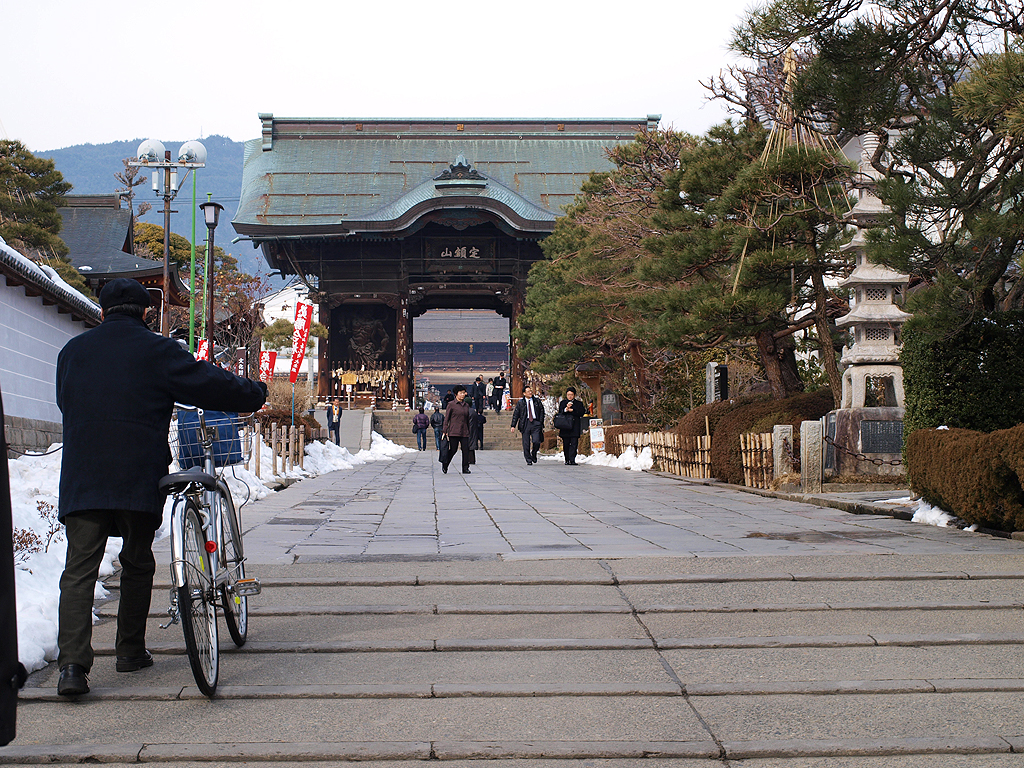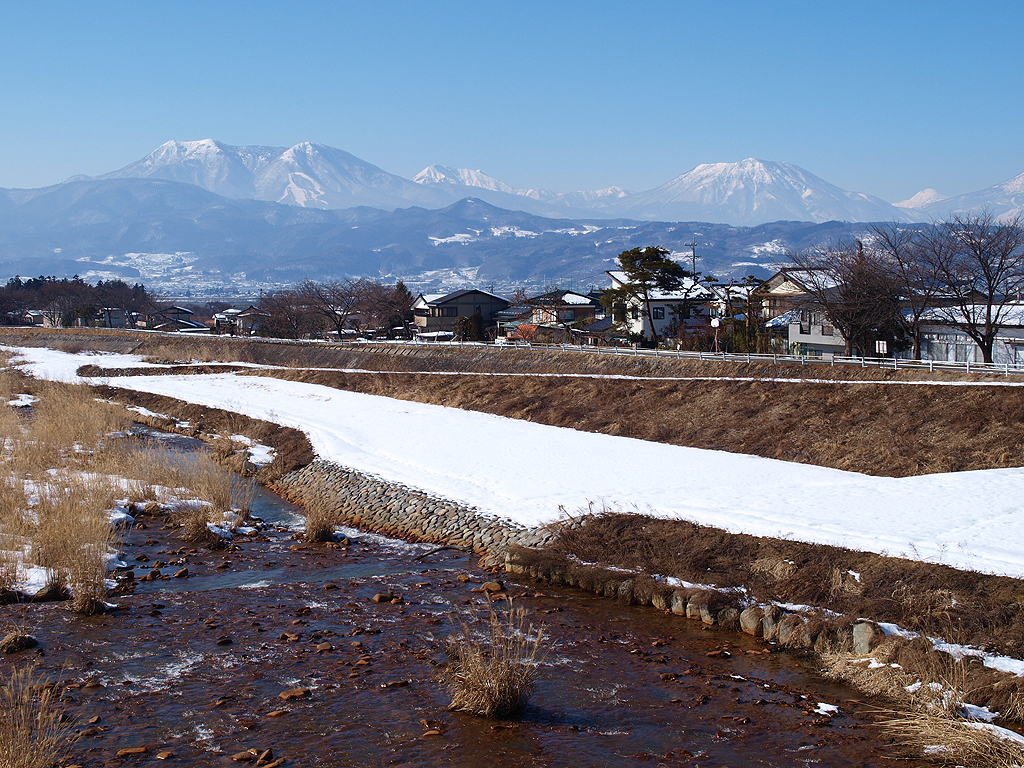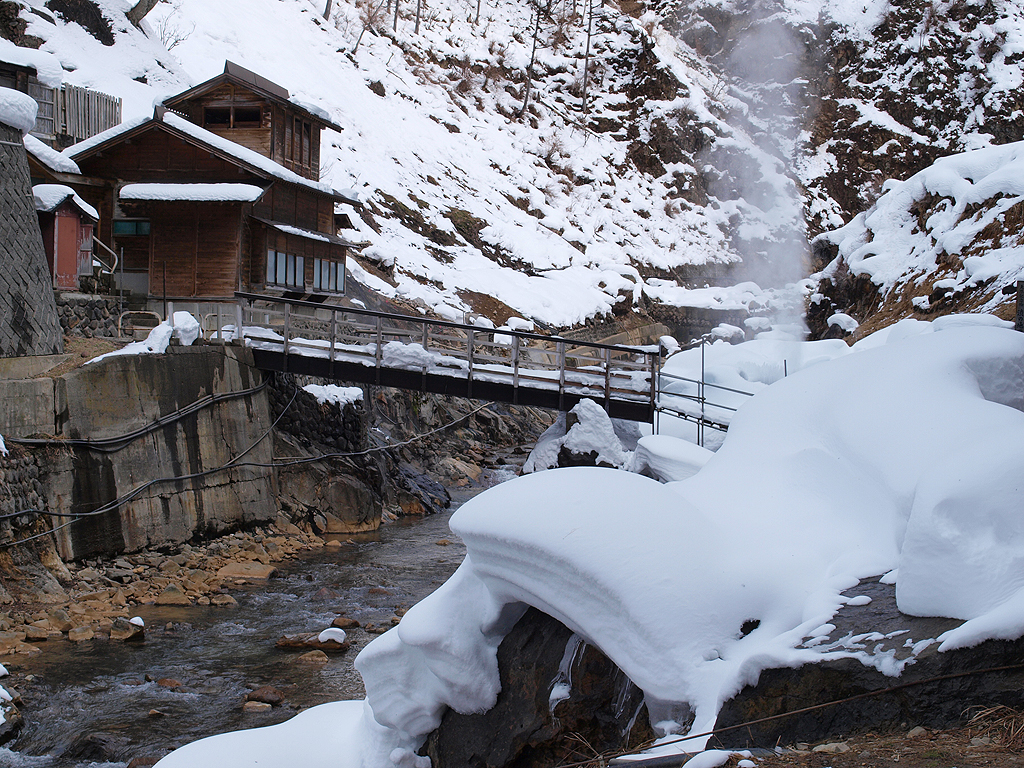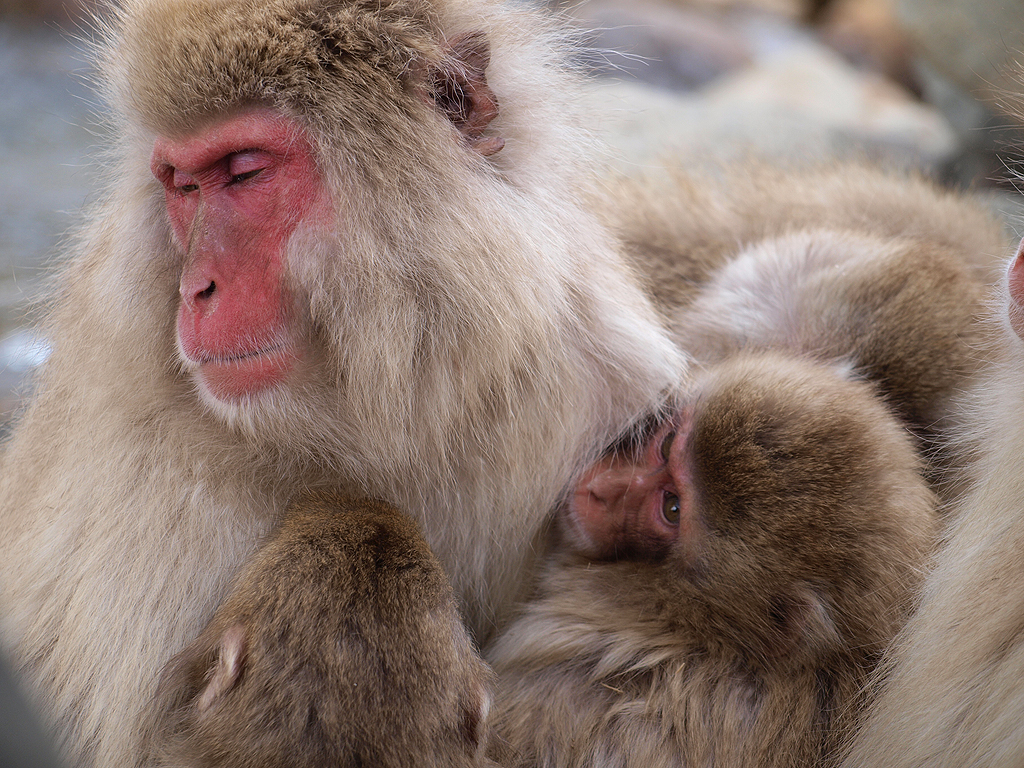When a Japanese friend learned that I was planning a winter trip to see the snow monkeys north of Nagano, she told me she had always wanted to see the Hokusai museum in nearby Obuse, so, although she was not fond of cold weather, she agreed to accompany me for a few days. It was February of 2010, and the night before we were to leave, Tokyo had its only significant snowfall of the season. By morning about three or four inches graced the roofs, bushes, and streets outside my window. My friend called. Apparently outlying areas had heavier snow and the highway bus we were planning to take had been cancelled. In addition, many trains were delayed or stopped, and downed trees caused road obstructions. Our local line was running, so we connected to the Shinkansen, bullet train, more expensive but much faster, and sped north to the mountains.
Switching trains at Nagano, we stopped for a soba lunch, and then detoured to see the grand Zenkō-ji Buddhist Temple. Handmade straw sandals hung at the entrance, brought as offerings to the gods. Hoping for good luck, visitors had rubbed the statue of Binzuru, a follower of Buddha, so that it shone in places. Many pilgrims stumbled through a completely dark underground passage, groping along the walls for a hidden key of enlightenment. Although my friend claimed not to be a believer, she threw the obligatory coin into the box at the steps of the temple, rang the bell, and clapped, observing the ritual prayer.
“You never know,” she said with a sly smile.





The celebrated artist of the Edo period, Katsushika Hokusai created ukiyo-e, woodblock prints. His depictions of huge foamy blue waves tossing wooden boats, and of the dramatic, solitary Mount Fuji, serene or stormy, floating over villages, are recognized around the world. An extensive collection of originals were housed at the Hokusai Museum in Obuse, along with his paintings, scrolls, and sketches. We trudged through blowing snow to see his fiery orange phoenix on the ceiling at the Gansho-in Temple, painted while Hokusai was in his eighties.



Hokusai’s patron in Obuse owned a sake factory, which now houses the museum; a smaller brewery and restaurant run by the same family could now be found on the main road. We sat at the counter to watch blue-robed young men preparing the food, chopping quickly and precisely with big sharp knives and steaming rice over an old stone oven. Three different kinds of sake, including a thick, milky wine similar to Korean makgeolli, were brought to us to sample, each one better than the last.
Under the town of Yudanaka, which clung to a steep mountainside, the earth seemed to be smoldering, dotted with steaming hot springs. Our hotel had an underground passageway to several natural spas, so we could wear the robe-like yukata and slippers supplied in our room without stepping outside. As usual in Japan, men and women bathed separately, in the nude. Both before dinner and after, we soaked in hot pools in rock basins, with fresh water dribbling down rock walls, pouring in from the side, bubbling up from the bottom.
My friend declined to join me on my morning trek to see Jigokudani Yaen-koen, Hell’s Valley Monkey Park, one of the most famous attractions in all of Japan, preferring to relax in the hotel. She did not want to hike on the snowy trail. This was truly inconceivable to me; I could hardly contain my excitement! To each her own. I just hoped there would be a few monkeys around on this slightly warmer morning to make the journey worthwhile.
After a thirty-minute walk from the trailhead on a snow-packed path through dense forest to a cluster of old wooden buildings along a river, I was thrilled to encounter my first Macaque monkey, a large reddish-brown male strolling by me without a glance. The sign pointed up steep stairs to the park entrance. The Monkey Park follows the river up to a steamy natural pool.




Suddenly monkeys were everywhere: playful youngsters rolling and frolicking in the snow, chasing each other up the hillside, bouncing off rocks, my camera bag, and even my head. They were hanging off signs, lone monkeys digging in the snow for morsels of food, sitting on rocks in the river, mothers nursing babies. Across a rickety bridge, pensive-looking monkeys lounged in the pond, heads with disheveled hair floating above the surface, lost in meditation, reaching down now and then to pick up things to eat from below the surface. These wild creatures ignored the human gawkers, oblivious to the cameras, and avoided eye contact, as if we were just other grazing animals in the valley. How enchanting to be able to share their remote habitat, if only for an hour or so.






This piece is an excerpt from my book, Go Wherever You Want (working title).
Please do not download or reproduce images from this site. ©
Your comments are welcome!
Popular posts/stats/categories
Email me at: Ruth@RuthRosenfeld.com
That is one of my dream destinations! The monkey in the hotsprings with wet, crazy hair is perfect. Maggie
LikeLiked by 2 people
It’s worth the trip, like a fantasy being there! I went again another time, although at a warmer time of year, I had to take my son when he came to visit. I was surprised the monkeys still frequent the bath and the area even when it’s not cold. Hope you get there! Thanks, Maggie.
LikeLike
Oh really, I was thinking I should have asked you if February is best. We want to go to Japan for skiing so it would probably be winter anyway. Thanks!!
LikeLiked by 1 person
When you go up that way, include Shirakawa-go, World Heritage Site, the town of steep thatched roofs.
LikeLiked by 1 person
Thanks!
LikeLiked by 1 person
How fun! Your friend surely missed out. I saw the little macaque monkeys at Arashiyama but it would be so neat to see them at these hot springs too.
LikeLiked by 3 people
The bamboo forest, kind of mystical place. We often don’t realize the treasures we have in our own backyard – I guess my friend didn’t think it was so special. Thanks for your comment, Jess.
LikeLiked by 1 person
Gorgeous photos of the bathing monkeys! The article perfectly encapsulates all that is wonderful about Japan: delicious food, beautiful nature, hot springs and Hokusai. Perfect trip!
LikeLiked by 3 people
Thank you, Leighton! I agree. You can tell I am a Japan lover!
LikeLiked by 1 person
What a wonderful trip, and equally wonderful read! Your descriptions of the journey, the food, the temple, the Hokusai museum are all entrancing, but of course the monkeys are the stars of the post. Like you I can’t imagine not wanting to go to see them!! I love all the photos, but the one with the spiky hair peering over a rock is especially captivating 🙂
LikeLiked by 2 people
Thank you, Sarah! I do love that one as well, looking like he just doesn’t want to get out of the bathtub. 🙂
LikeLiked by 1 person
You are one lucky lady, Ruth – what an experience! I can’t even pretend that I feel anything other than envy. 😊 The photographs are just perfect. I have always been curious about the Japanese monkeys with their spa. Maybe I will add Japan to the bucket list again…
LikeLiked by 3 people
It was a choice to go there, as with many things, I don’t consider it luck. 🙂 It was always someplace I wanted to get to when I got the job in Japan. It takes a few extra days to wander up north, so if you go, keep that in mind. Thanks for reading, Kerry!
LikeLiked by 2 people
You are right, Ruth, it wasn’t luck but an excellent choice. There is so much to admire about you and your life. My cousin traveled to Laos and Guatemala with the intention of teaching local people to use sewing machines to make their handicrafts more saleable. Travel with a purpose.
LikeLiked by 1 person
Interesting to bring sewing machines to indigenous crafts. I hope your cousin found some interest. Guatemalan weavings are so beautiful and unique.
LikeLiked by 1 person
She did find some interest but then the funding for the proposed project disappeared.
LikeLiked by 1 person
Sorry to hear that.
LikeLiked by 1 person
Quite an adventure. Reading this essay made me want to visit Japan. I doubt that I will, but you never know.
LikeLiked by 2 people
Thanks for reading, Neil. Japan has such a unique culture, with or without the monkeys. Cheers.
LikeLiked by 1 person
What a great trip and experience. I have only passed through Nagano and never stopped. Have to give it a look some time, not sure about a winter visit though. Thanks for sharing Ruth. Allan
LikeLiked by 3 people
I didn’t spend more than a few hours in Nagano. I’m sure it’s worth a longer trip, especially if you are a skier. I appreciate your visit and comment, Allan.
LikeLiked by 1 person
Gosh, what a STUNNING day at Jigokudani! From the artfully-presented soba lunch to the crisp views of the snow-capped mountains, it looks like you had the perfect weather and food that day, along with plenty of adorable monkeys to boot! I’ve not been to that part of Japan yet, but your post has inspired me to return to the island country to check it out!
LikeLiked by 2 people
It was definitely worth the journey up north, each part special in its own way. I am reminded of the Paul Simon line about the zoo: “and the animals will love it if you do”, but I don’t think they cared. Thanks for your kind comment, Rebecca!
LikeLiked by 1 person
Wow! So cool! ha ha. That is a trip I’d like to try sometime. I’ve seen snowy owls but never a snow monkey.
LikeLiked by 2 people
It was an awesome sight, and worth doing. This is certainly a unique pastime for monkeys! Thanks for visiting.
LikeLike
What a fabulous experience! Your images are wonderful, Ruth. Your portraits of the monkeys are endearing and special.
LikeLiked by 2 people
Thanks so much, Jane! I had lots of photos from that day, but the portraits stand out.
LikeLiked by 1 person
WOW! What an amazing experience. I have only seen those monkeys in photos. It would be so special to see them in real life. I am envious!
LikeLiked by 3 people
It almost seemed like stepping into a fantasy, their community, kids and babies, and their activities revolved around the hot springs water. Glad you enjoyed it, Mel!
LikeLiked by 1 person
One of those ‘pinch yourself’ moments.
LikeLiked by 1 person
Thank you for taking us to these special places. My compliments for your pictures of the apes, they are realy gorgeous.
LikeLiked by 2 people
It’s a treat to share them with you and take you along. I appreciate your kind comment, Rudi!
LikeLike
What an awesome trip! Your Soba lunch looks quite interesting … and how special to see these monkeys in their natural habitat! Can I just say ‘awww’ for that little one ☺️ – must have been a wonderful experience!
LikeLiked by 3 people
That it was. The Japanese are artful in their food presentations. I don’t usually take photos of food, but this one was so attractive, I almost hated to disturb it by eating! Thanks for taking the time to comment, Corna.
LikeLike
my what pensive looks they have, but those lovely fur coats must keep them warm! Sorry your friend missed such a treat! You either have an excellent memory or kept detailed notes to recall so much … thanks for sharing 🙂
LikeLiked by 2 people
Those faces, you wonder what they are thinking… I journaled extensively when I lived abroad. Thank you, Kate!
LikeLiked by 1 person
good for you! It’s was my intention to but like most good intention it fell by the wayside! How lovely that you can share such travels now we are all house-bound! A delicious escape, especially with such detail and exotic pics, thanks Ruth 🙂
LikeLiked by 1 person
This post is wonderful!
… and the photos are gorgeous
LikeLiked by 2 people
I appreciate your kind comment, Luisa!
LikeLiked by 1 person
We visited Japan a few years ago, but unfortunately didn’t have enough time to go to Nagano. The landscape looks so pretty covered in snow. And how neat to see all those monkeys. I’m sure they were quite entertaining to watch.
LikeLiked by 2 people
It’s pretty chilly and rugged up in northern Honshu. It was a delight to watch the monkeys! All the visitors were entranced.
LikeLiked by 1 person
It’s SO beautiful, what an incredible experience to see Nagano in winter and visit the monkeys. Incredible 🙂 thanks for sharing
LikeLiked by 2 people
Thanks for taking the time to read and comment, Hannah!
LikeLiked by 1 person
What a wonderful excursion – all of it! I also do not understand your friend, and would have been as excited as you to get to the monkey park. It has long been on my radar. The rest of the journey sounds lovely too. And your photos are gorgeous.
Alison
LikeLiked by 2 people
Thanks so much, Alison, for coming along and for your kind comments.
LikeLiked by 1 person
Fascinating creatures. I’m with you – nothing could keep me away from a place like that!
LikeLiked by 2 people
We rarely associate apes and monkeys with snowy backdrops. These are amazing photos.
LikeLiked by 2 people
Thank you, Jay. It’s a unique place and the macaques have adapted so wonderfully. A pleasure to spend time spying on their lifestyle.
LikeLike
Ruth, a truly magical experience for you. The photos are wonderful. I don’t like flying but already I have a list of places, including this one, that could lead me to overcome my reluctance.
LikeLiked by 1 person
Thank you, Tracy, for visiting and taking the time to comment. It was magical! Those moments were a vision into another little world.
LikeLiked by 1 person
You’re welcome, Ruth. It is absolute pleasure to visit you here.
LikeLiked by 1 person
Thank you for letting me ‘join’ you on the journey, Ruth. I’d say the hike was definitely worth it!
LikeLiked by 1 person
It was certainly worth it! So much so that I went there again to take my son when he came to visit. It was warmer then, no snow, but the monkeys were still soaking in the hot pool. Thanks for coming along.
LikeLiked by 1 person